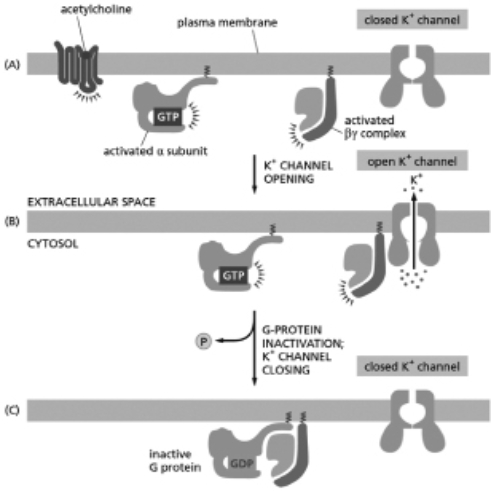Course
Cell Biology
Study Pack
Set 16 Cell Signaling
Question 1
(Multiple Choice)
Free
During the mating process, yeast cells respond to pheromones secreted by other yeast cells.These pheromones bind GPCRs on the surface of the responding cell and lead to the activation of G proteins inside the cell.When a wild-type yeast cell senses the pheromone, its physiology changes in preparation for mating: the cell stops growing until it finds a mating partner.If yeast cells do not undergo the appropriate response after sensing a pheromone, they are considered sterile.Yeast cells that are defective in one or more components of the G protein have characteristic phenotypes in the absence and presence of the pheromone, which are listed in Table 16-14. mutation none (wild type) α subunit deleted β subunit deleted γ subunit deleted α and β deleted α and γ deleted β and γ deleted phenotype minus pheromone normal growth arrested growth normal growth normal growth normal growth normal growth normal growth plus pheromone arrested growth, mating response arrested growth, sterile normal growth, sterile normal growth, sterile normal growth, sterile normal growth, sterile normal growth, sterile Table 16-14
Which of the following models is consistent with the data from the analysis of these mutants? Explain your answer.
Which of the following models is consistent with the data from the analysis of these mutants? Explain your answer.
A)The ? subunit activates the mating response but is inhibited when bound to ??.
B)The ?? subunit activates the mating response but is inhibited when bound to ?.
C)The G protein is inactive; either the free ? or free ?? complex is capable of activating the mating response.
D)The G protein is active; both free ? and free ?? complex are required to inhibit the mating response.
Answer
Question 2
(Multiple Choice)
Free
Which of the following statements about G-protein-coupled receptors (GPCRs) is FALSE?
A)GPCRs are the largest family of cell-surface receptors in humans.
B)GPCRs are used in endocrine, paracrine, and neuronal signaling.
C)GPCRs are found in yeast, mice, and humans.
D)The different classes of GPCR ligands (proteins, amino acid derivatives, or fatty acids) bind to receptors with different numbers of transmembrane domains.
Answer
Question 3
(Multiple Choice)
Free
Acetylcholine binds to a GPCR on heart muscle, making the heart beat more slowly.The activated receptor stimulates a G protein, which opens a K+ channel in the plasma membrane, as shown in Figure 16-13.Which of the following would enhance this effect of the acetylcholine?  Figure 16-13
Figure 16-13
 Figure 16-13
Figure 16-13A)addition of a high concentration of a nonhydrolyzable analog of GTP
B)addition of a drug that prevents the α subunit from exchanging GDP for GTP
C)mutations in the acetylcholine receptor that weaken the interaction between the receptor and acetylcholine
D)mutations in the acetylcholine receptor that weaken the interaction between the receptor and the G protein
Answer